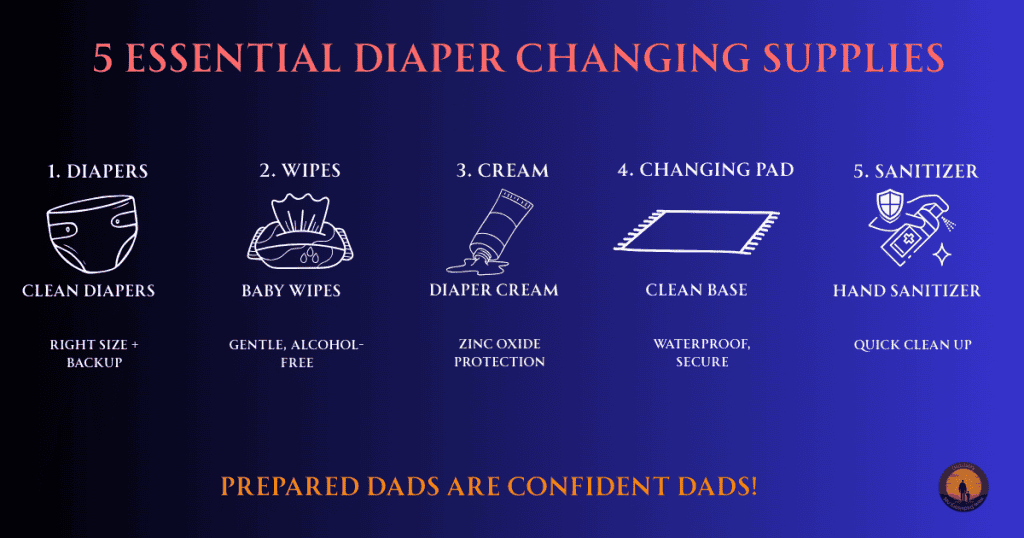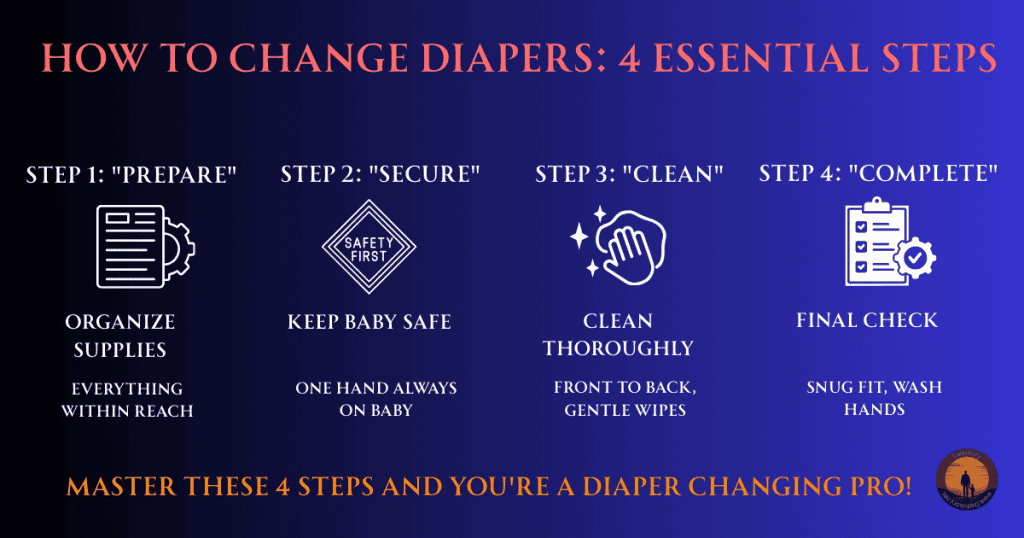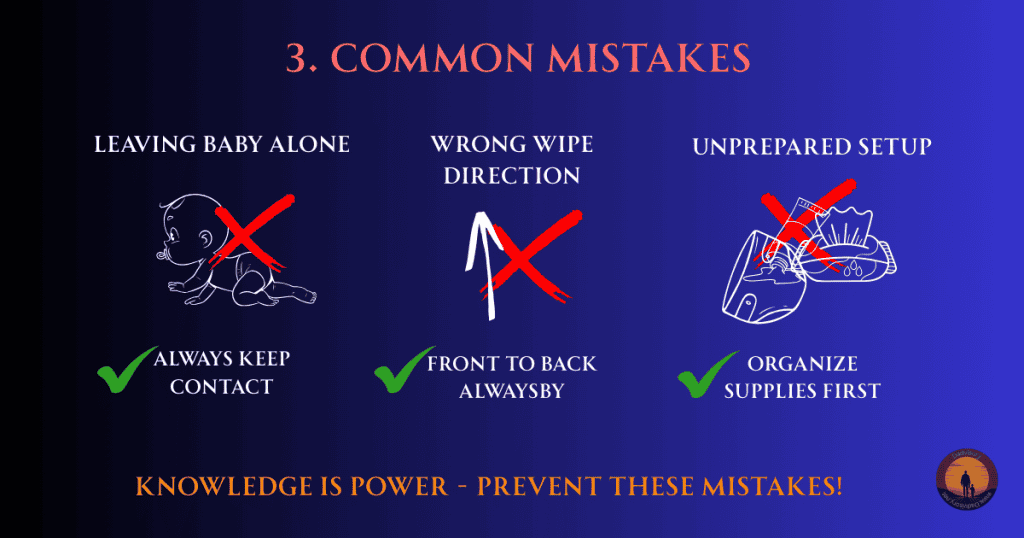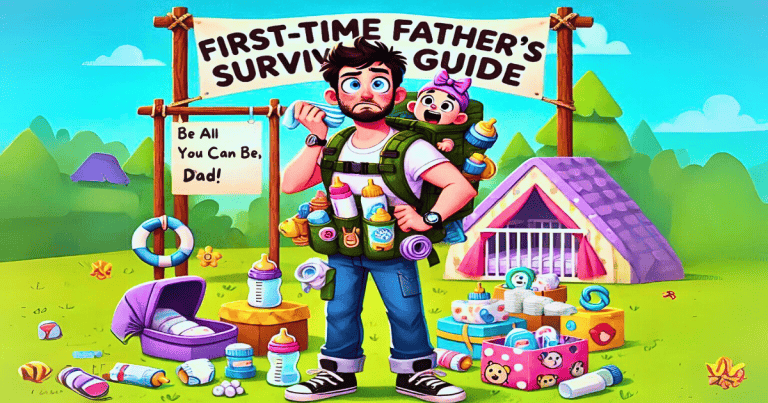How to Change Diapers for Dads: Complete 2026 Guide

I’ll never forget that moment in the hospital when the nurse handed me my newborn son and said, “Dad, time for his first diaper change!” Surprisingly, I didn’t panic. Despite never having contact with a child younger than 8 months, something clicked into place – complete calm and focus took over. Maybe it was the protective instinct, the sense of responsibility, or simply seeing my partner’s exhausted but hopeful face. But in that moment, understanding how to change diapers felt natural and necessary.
With full composure, I carefully removed the wet diaper and put on a fresh one. The midwife gave me just two quick tips, and that was it – mission accomplished. The calm satisfaction on my partner’s face was priceless. I could see in her eyes that she knew she could count on me for this essential parenting duty. That first successful diaper change set the foundation for mastering diaper changing throughout our entire parenting journey.
Learning how to change diapers for dads isn’t just about mastering a practical skill – it’s about building confidence, creating bonding moments, and showing your partner that you’re fully committed to baby care. Whether you’re preparing for your first child or looking to improve your technique, this comprehensive guide on how to change diapers will transform you from nervous beginner to confident father.
Essential Diaper Changing Supplies for New Dads
Before mastering how to change diapers for dads, you need the right baby supplies organized and ready. Creating an efficient changing station is like preparing your workspace – everything should be within arm’s reach when you need it most. The foundation of successful diaper changing technique starts with proper preparation and organization.
Your core diaper changing essentials include quality disposable diapers or cloth diapers (depending on your preference), gentle baby wipes designed for sensitive skin, diaper cream for protection, and a comfortable changing pad. I learned quickly that having backup supplies readily available saves precious time during those inevitable messy situations that every father encounters when learning how to change diapers for dads. For comprehensive guidance on all essential gear every new dad needs, check out our complete new dad essentials guide.
Must-Have Items for Every Dad’s Changing Station
Primary Supplies:
- Diapers in current size plus one size larger
- Alcohol-free, fragrance-free baby wipes
- Zinc oxide diaper cream for diaper rash prevention
- Waterproof changing pad with raised edges
- Safety straps for changing table security
- Hand sanitizer for quick cleanup
Emergency Backup Kit:
- Extra baby clothes in multiple sizes
- Spare changing pad covers
- Disposable changing pad liners
- Sealed diaper disposal bags
- Clean towels for unexpected spills
Portable Diaper Bag Essentials: When you’re mastering how to change diapers on the go, portability becomes crucial. Pack a compact diaper bag with travel-sized versions of your home supplies. Include plastic bags for dirty clothes and always carry more diapers than you think you’ll need. This lesson applies to every aspect of changing diapers for dads, whether at home or traveling. Planning for hospital visits? Our first-time dad’s hospital bag checklist covers everything you need for those crucial first days.
The key to successful diaper changing lies in preparation and organization. Every second counts when you’re dealing with a squirmy baby or trying to prevent diaper leaks from becoming a bigger mess. These preparation skills are fundamental to changing diapers effectively.

Step-by-Step Guide: How to Change Diapers for Dads
Mastering how to change diapers for dads requires developing a consistent routine that works under pressure. Here’s the proven method that’s served me through hundreds of diaper changes, from calm newborn sessions to wrestling matches with energetic toddlers. This step-by-step approach will build your confidence with every successful change.

Step 1: Preparation and Safety Setup
Before beginning any diaper change, organize your baby supplies within easy reach. This preparation phase is absolutely critical when learning how to change diapers effectively. Lay out your clean diaper, baby wipes, and diaper cream. Ensure your changing pad is secure and safety straps are ready.
Never underestimate the importance of proper setup in diaper changing. Babies have an uncanny ability to sense when you’re unprepared, and that’s exactly when they’ll decide to test your reflexes with unexpected movements or additional surprises.
Step 2: Secure Your Baby Safely
Place your baby on the changing station and immediately engage any safety straps. Keep one hand on your baby at all times – this is fundamental to safe diaper changing practices. Even newborns can surprise you with sudden movements, and mobile babies are like tiny escape artists. The American Academy of Pediatrics emphasizes that constant supervision is the most important safety measure during diaper changes.
The golden rule of how to change diapers: never turn your back or step away from a baby on a changing table, even for a second. If you forgot something essential, either take the baby with you or hold them while reaching for supplies.
Step 3: Remove the Dirty Diaper Carefully
Open the diaper tabs slowly but don’t remove the wet diaper immediately. For boys, I always recommend having a clean diaper or cloth ready to cover them – this learned experience will save you from unexpected showers! This technique is essential when changing baby boys. Lift your baby’s legs gently by the ankles and slide the dirty diaper away from their bottom.
This step requires patience and gentle handling in your diaper changing routine. Never rush through dirty diaper removal, especially if you’re dealing with a messy situation. Take your time to prevent spreading the mess to clean areas.
Step 4: Thorough but Gentle Cleaning
Proper baby hygiene starts with thorough cleaning using baby wipes. Always wipe from front to back, using multiple wipes if necessary. This technique prevents diaper rash and maintains your baby’s skin health throughout their diaper-wearing years. Mastering this cleaning process is crucial for successful diaper change execution. Mayo Clinic recommends changing diapers promptly and cleaning gently to prevent diaper rash.
For girls, pay special attention to wiping from front to back to prevent infections. Following NHS guidelines, always wipe from front to back using multiple wipes if needed. For boys, clean all the creases and folds where moisture can hide. Don’t forget to clean the diaper area completely, including the legs and lower back where leaks might have occurred. These details matter in proper baby care.
Step 5: Apply Diaper Cream Protection
Even without visible irritation, applying a thin layer of diaper cream creates a protective barrier for your baby’s skin. This preventive approach to baby care helps avoid painful diaper rash that can make future diaper changes more challenging for everyone involved.
If you notice any redness on your baby’s bottom, apply diaper cream more generously. Zinc oxide-based creams provide excellent protection and healing properties for sensitive skin throughout your parenting journey.
Step 6: Fresh Diaper Application Technique
Slide the clean diaper under your baby’s bottom, ensuring the back portion comes up higher than the front. This proper diaper fit prevents leaks and ensures comfort throughout wear time. Bring the front section between your baby’s legs and secure the diaper tabs snugly but not too tight. Perfect execution of this step is essential for successful diaper change technique.
The perfect diaper fit allows you to slide two fingers between the diaper and your baby’s belly. Too loose leads to leaks; too tight causes discomfort and red marks on your baby’s skin. Getting this balance right improves your overall diaper changing skills significantly.
Step 7: Final Check and Cleanup
Ensure the leg cuffs are pulled out properly to create a seal that prevents diaper leaks. Check that the diaper size provides comfortable coverage around your baby’s waist and thighs. Dispose of the dirty diaper in your sealed disposal system and wash your hands thoroughly. Completing this final step properly rounds out effective diaper changing execution.
This final inspection step prevents many common diaper problems. A properly fitted diaper should sit below the umbilical cord area for newborns and provide full coverage without gaps around the legs. Attention to these details distinguishes expert diaper changing technique from amateur attempts.
Understanding Different Diaper Types
Learning how to change diapers means understanding that not all diapers are created equal. Your choice between disposable diapers and cloth diapers affects your changing technique, storage needs, and overall parenting routine. Different diaper types require slight modifications to your changing approach.
Disposable Diapers: Convenience and Performance
Disposable diapers offer convenience and superior absorbency, making them ideal for new dads building confidence in changing diapers. Modern disposables include wetness indicators, stretchy sides, and improved fit designs that accommodate active babies while simplifying your changing routine.
Sizing Guidelines for Proper Fit:
- Newborn: 6-9 pounds
- Size 1: 8-14 pounds
- Size 2: 12-18 pounds
- Size 3: 16-28 pounds
- Size 4: 22-37 pounds
- Size 5: 27+ pounds
Don’t rely solely on weight when selecting diaper size for your changing routine. Every baby’s body shape differs, and you’ll learn your child’s specific needs through experience. Signs it’s time to size up include red marks around the waist or legs, frequent leaks, or difficulty fastening the tabs comfortably.
Cloth Diapers: Eco-Friendly Alternative
Cloth diapers require more technique but offer environmental benefits and long-term cost savings. If you choose cloth diapers, expect a steeper learning curve in your diaper-changing journey. The folding, securing, and fitting process takes practice, but many fathers find the process rewarding once they master the technique.
Modern cloth diaper systems include all-in-one designs, pocket diapers, and traditional prefolds with covers. Each type requires slightly different changing techniques, so invest time in learning your chosen system thoroughly for optimal results.
Specialized Diaper Options
Overnight diapers provide extra absorbency for longer sleep periods, reducing nighttime disruptions to your sleep schedule. Pull-up diapers work excellently for standing changes and help transition toward potty training when your child is ready, making advanced diaper changing techniques much easier.
Troubleshooting Common Challenges
Every dad faces challenges when learning how to change diapers, from dealing with squirmy babies to handling unexpected messes. Here’s how to manage the most common situations with confidence and humor while maintaining your diaper changing expertise.
Managing Squirmy Babies and Diaper Resistance
As babies grow more active, your diaper changing routine can feel like wrestling a tiny, determined athlete. The calm, easy diaper changes of early newborn days give way to wiggling, rolling, and escape attempts that test your patience and reflexes during changing sessions.
Distraction Techniques That Work:
- Sing silly songs or make funny faces during diaper changes
- Give them a special toy reserved only for diaper time
- Point out interesting ceiling features or lights
- Make diaper changing a game with counting or peek-a-boo
The key is keeping their attention focused elsewhere while you work efficiently. Some babies respond well to gentle but firm holding, while others prefer engaging conversation throughout your changing process.
Handling Unpleasant Odors and Messy Situations
Let’s be honest – some sessions of changing involve odors that could knock you off your feet. While we never experienced major blowouts, we certainly dealt with smells that were absolutely overwhelming during our parenting journey. There’s also the classic timing issue: your baby finishing their business in a fresh, clean diaper immediately after you’ve completed the change, as if they were waiting for clean accommodations.
Odor Management Strategies:
- Breathe through your mouth during particularly challenging diaper changes
- Use a small dab of mentholated ointment under your nose
- Open windows or turn on fans for ventilation during changes
- Keep disposal bags or systems sealed immediately
- Accept that some smells are simply part of learning baby care
The timing phenomenon seems universal among babies – they have an uncanny ability to know exactly when you’ve just finished changing them. Don’t take it personally; it’s just another part of the parenting adventure that becomes easier with experience and humor.

Nighttime Changes: Keeping Everyone Sleepy
Nighttime changes of diapers require a completely different approach to maintain sleepy moods for everyone involved. The goal is efficiency and minimal disruption while ensuring your baby stays comfortable throughout the night during these special changing sessions.
Nighttime Changing Strategy:
- Use dim lighting or small nightlights instead of bright overhead lights
- Keep all supplies organized in bedside caddies
- Change only truly necessary wet or dirty diapers
- Work quietly and avoid stimulating conversation during changes
- Consider overnight diapers for extended protection
Some babies can sleep through wet diapers if they’re not uncomfortable, so evaluate whether nighttime diaper changing is truly necessary before proceeding.
Advanced Techniques: Standing Changes and Mobile Babies
Once your baby becomes mobile, traditional lying-down sessions become increasingly challenging. Learning how to change diapers includes mastering standing changes, which often become necessary around 12-18 months when toddlers prefer staying upright and resist conventional positioning.
Mastering Standing Diaper Changes
Standing diaper changes are simply a practical adaptation when your little one starts walking and refuses to lie down cooperatively. The key is proposing the standing change in their favorite location where they have interesting views and engaging surroundings to keep them occupied during diaper change.
Standing Change Technique:
- Choose a location with good distractions (window views, mirrors, toys)
- Have all supplies ready before starting your standing changing session
- Work quickly but safely – toddlers won’t stand still for long
- Keep conversation going to maintain their attention throughout the process
- Be prepared to finish the job while chasing a naked toddler
Speed is definitely indicated here for standing diaper changes. I guarantee that an active toddler won’t stand in place for extended periods, and you might find yourself running after a naked child who’s decided the changing session is complete regardless of your progress.
Adapting Your Technique for Growing Children
As children develop, their diaper changing needs evolve significantly. What worked for a compliant newborn requires major adjustments for an opinionated toddler with strong preferences about everything from diaper position to changing location.
Age-Appropriate Adaptations:
- 6-12 months: Increase distraction techniques as mobility develops
- 12-18 months: Introduce standing changes and choice-giving
- 18+ months: Use pull-up diapers and involve them in the process
- Potty training age: Emphasize independence and transition skills
Remember that resistance to diaper changes often signals readiness for potty training discussions. Pay attention to your child’s cues about independence and bathroom awareness.
Creating the Perfect Environment
Your changing environment significantly impacts how smoothly whole process will proceed. A well-organized, comfortable space makes the process more efficient and pleasant for both you and your baby, especially when you’re still building confidence in baby care.
Setting Up Multiple Changing Stations
Having changing stations throughout your home provides convenience and reduces trips up and down stairs during busy periods. Your main nursery station should be fully equipped with all supplies and safety features, while secondary stations in living areas can handle quick changes without major preparation.
Primary Changing Station Features:
- Sturdy changing table with safety straps for secure diaper changes
- Organized storage for all diaper supplies
- Good lighting for detailed cleaning during changes
- Comfortable height to prevent back strain
- Easy-to-clean surfaces for inevitable spills
Secondary Station Essentials:
- Portable changing pad for floor-based changes
- Basic supply basket with diapers, wipes, and cream
- Nearby trash receptacle or disposal bags
- Hand sanitizer for quick cleanup after changes
Consider the flow of your daily routine when positioning changing stations for optimal accessibility. Having supplies accessible in your main living areas prevents carrying babies up and down stairs multiple times daily.
Safety First: Preventing Accidents
Safety must be your absolute top priority every time you change a diaper. Babies develop surprising strength and mobility quickly, and even newborns can kick powerfully or roll unexpectedly during changing sessions.
Essential Safety Protocols
Never underestimate a baby’s ability to move quickly when you least expect it during diaper changes. Maintaining constant physical contact and supervision prevents falls and injuries that can occur in split seconds during changing sessions.
Non-Negotiable Safety Rules:
- Always keep one hand on your baby during changes
- Use safety straps when available, but don’t rely on them exclusively
- Never leave a baby unattended on a changing surface
- Keep dangerous items out of reach during changes
- Maintain firm but gentle control throughout the process
If you must step away or turn around for any reason during diaper duty, take your baby with you or place them safely on the floor. No supply is worth risking your child’s safety.
Money-Saving Strategies for Diaper Expenses
Diaper costs add up quickly over your child’s diaper-wearing years. Smart shopping and strategic planning can significantly reduce your overall diaper expenses without compromising quality or convenience in your baby care routine.
Bulk Buying and Storage Solutions
Warehouse stores and bulk purchasing offer the best per-diaper value for families committed to specific brands that work well with their changing routine. However, avoid over-purchasing until you’ve tested different brands to find what works best for your baby’s skin and body shape.
Bulk Buying Guidelines:
- Start with small packages to test fit and performance in your routine
- Buy larger quantities once you’ve identified preferred brands
- Consider storage space limitations in your planning
- Factor in your baby’s growth rate when calculating needs
- Take advantage of sales cycles and promotional periods
Comparing Disposable vs. Cloth Diaper Costs
While cloth diapers require higher upfront investment, they can provide substantial savings over multiple children. Factor in washing costs, time investment, and convenience when calculating true expenses for your family situation.
Cost Comparison Factors:
- Initial purchase price vs. ongoing buying costs
- Water, detergent, and electricity for washing cloth diapers
- Time investment for washing, drying, and prep work
- Daycare requirements and policies for different diaper types
- Resale value of cloth diapers after use
Building Confidence and Bonding
Learning how to change diapers represents much more than mastering a practical skill. These daily interactions become opportunities for bonding, communication, and building trust with your child while demonstrating reliability to your partner through competent baby care.
Creating Positive Associations
Transform diaper changing from a chore into connection time by talking, singing, or playing gentle games throughout the process. This constant communication during changes helps with your baby’s language development while creating positive associations with caregiving routines.
Bonding Techniques During Changes:
- Maintain eye contact and smile frequently throughout diaper changes
- Describe what you’re doing in a calm, reassuring voice
- Sing songs or recite nursery rhymes consistently during changes
- Use gentle tickling or playful touches appropriately
- Celebrate successful changing sessions with praise and enthusiasm
These interactions build your confidence as a caregiver while showing your baby that diaper changes can be pleasant, predictable experiences rather than stressful interruptions.
Demonstrating Partnership and Reliability
Every successful diaper change demonstrates to your partner that they can rely on you for essential baby care tasks. This reliability builds trust and allows for more balanced sharing of parenting responsibilities throughout your child’s development.
Your growing competence in changing your baby’s diaper often translates into confidence in other areas of baby care, from feeding and bathing to soothing and playing. These skills build upon each other to create overall parenting confidence.
Professional Tips for Advanced Success
Once you’ve mastered the basics of how to change diapers, these advanced techniques will boost your efficiency and confidence. Speed isn’t everything, but developing smooth, quick changes helps minimize fussing and makes the process more pleasant for everyone.
One-Handed Changing Skills
Practice opening wipes packages and diaper tabs with one hand while keeping the other on baby. Keep supplies organized so you can grab everything without looking. This skill becomes essential when dealing with particularly active babies.
Travel Diaper Changing Mastery
Always carry a portable changing pad – public surfaces aren’t always clean. Scout out changing facilities when you arrive somewhere new. In emergencies, car trunks, park benches with changing pads, or even clean floors can work, but always prioritize safety over convenience.
Building Routine and Bonding
Talk to your baby throughout the process, explaining what you’re doing. This constant communication helps with language development and creates positive associations with diaper changes. Some of my best bonding moments happened during quiet diaper changes when it was just me and my son.
Q: How often should I change my baby’s diaper?
A: Newborns typically need diaper changes every 2-3 hours, or immediately after bowel movements
Q: What’s the best diaper cream for new dads to use?
A: Zinc oxide-based creams work well for both prevention and treatment of diaper rash.
Q: Can I learn to change diapers for dads without prior experience?
A: Absolutely! Most dads learn quickly with practice – it becomes second nature within a few weeks.
Q: What should I do if my baby won’t stay still during diaper changes?
A: Try making silly faces, singing songs, or giving them a toy to hold during changes.
Q: How can I make nighttime diaper changes easier?
A: Keep lighting dim, have all supplies ready beforehand, and consider if the diaper actually needs changing
Conclusion: From Nervous Beginner to Confident Dad
Mastering how to change diapers is truly a journey of growth, patience, and unexpected moments of connection. From that first calm moment in the hospital to chasing a naked toddler around the living room, every diaper change teaches you something new about your child and yourself as a father.
The transition from nervous uncertainty to confident competence happens gradually through repetition and experience. Those early careful changes give way to efficient routines, and eventually, you’ll find yourself changing diapers while half-asleep, carrying on conversations, or even multitasking safely.
Remember that every dad starts somewhere with this essential parenting skill, whether with calm confidence or complete panic. The most important elements are patience with yourself, focus on your baby’s needs, and willingness to adapt as your child grows and changes. Perfect technique matters less than consistent care and genuine attention to your baby’s comfort and safety.
The skills you develop while learning how to change diapers extend far beyond this single task. The patience, observation, and gentle handling techniques transfer to countless other aspects of parenting, from feeding and bathing to comforting and playing.
Every diaper change represents an opportunity to strengthen your bond with your child while building your confidence as an active, engaged father. Whether you’re dealing with pleasant routine changes or challenging situations that test your resolve, approach each session with humor, patience, and the knowledge that this phase won’t last forever.
Your journey in learning how to change diapers is part of the broader adventure of fatherhood – full of unexpected moments, learning opportunities, and the gradual realization that you’re more capable and resilient than you ever imagined. Embrace the process, celebrate the small victories, and remember that every expert dad was once exactly where you are now.



